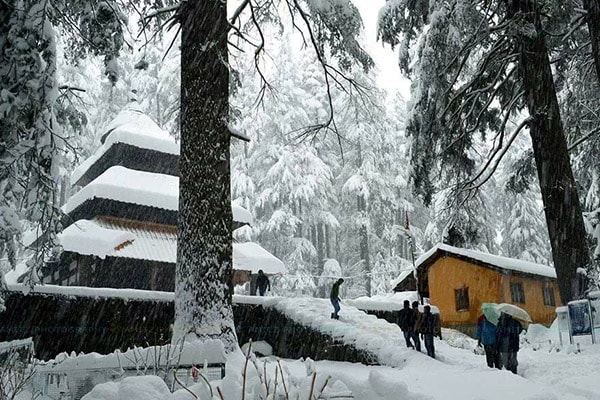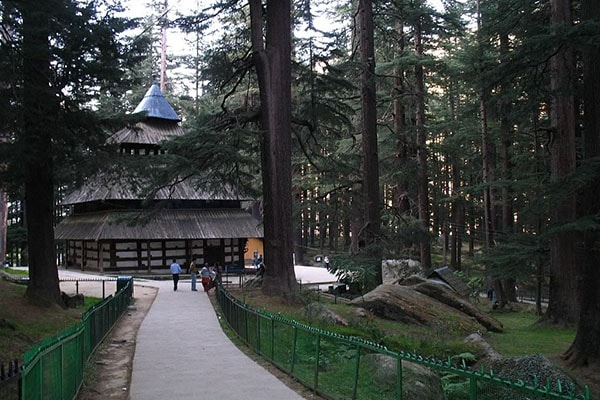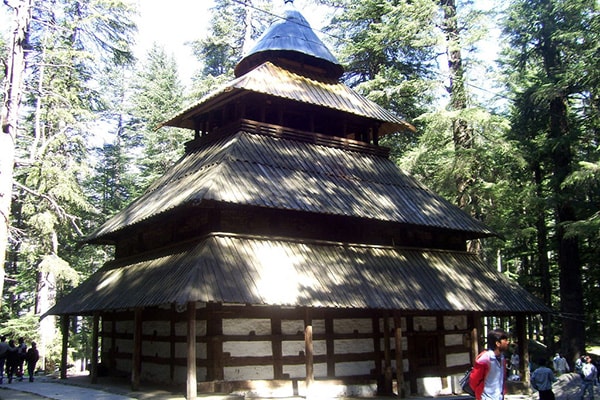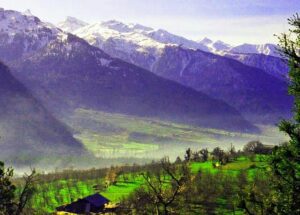The Hadimba Devi Temple is an ancient cave temple dedicated to Hadimba Devi, sister of Hadimb, who was a character in the Mahabharata.
Goddess Hadimba was the sister of the demon Hadimb who ruled the mountains and was feared by all. Situated at the foot of the Himalayas, the temple is surrounded by a cedar forest. Dating back to 1553, the temple is built over a huge rock jutting out of the ground, which was worshipped as an image of the deity. The patron-deity of the Rajahs of Kullu, Hadimba married Bhima, the Pandava brother. Legend states that the Pandavas stayed in Himachal during their exile, where Bhima was attacked by Hadimb. After killing her brother, Bhima married her. In the final years of her life, she went to the woods called Dhungri Van Vihar to meditate. At the place of her meditation, the temple was built in the year 1553 in Pagoda style. The wooden four-storey structure is also known as the Dhungri Temple. 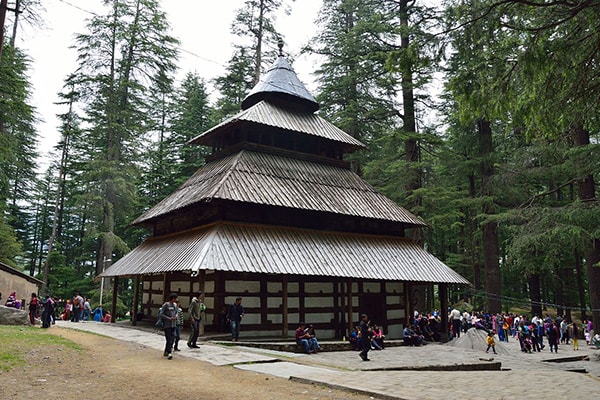 The temple does not contain any idol, just a footprint on a stone. Legend behind the construction of the temple states that the king who commissioned this temple was so awestruck by its beauty that he ordered the artist’s right hand to be cut. This was done in order to avoid his being able to repeat his masterpiece.
The temple does not contain any idol, just a footprint on a stone. Legend behind the construction of the temple states that the king who commissioned this temple was so awestruck by its beauty that he ordered the artist’s right hand to be cut. This was done in order to avoid his being able to repeat his masterpiece.
Temple Architecture
The Hidimba Devi Temple has intricately carved wooden doors and a 24 meters tall wooden “shikhar” or tower above the sanctuary. The tower consists of three square roofs covered with timber tiles and a fourth brass cone-shaped roof at the top. The door of the temple is adorned with beautiful carvings of images of Goddess Durga. The temple base is made out of whitewashed, mud-covered stonework. An enormous rock occupies the inside of the temple, only a 7.5 cm (3 inch) tall brass image representing goddess Hidimdi Devi. A rope hangs down in front of the rock, and according to a legend, in bygone days religious zealots would tie the hands of “sinners” by the rope and then swing them against the rock.
Ghatotkacha Temple
About 70 metres away from the temple, there is a shrine dedicated to Goddess Hidimdi’s son, Ghatotkacha who was born after she married Bhima. Owing to Hadimba’s emergence as the patron goddess of the Rajahs, her blessing is considered necessary by them before every coronation. To seek her blessings, devotees sacrifice a buffalo at the temple, prior to every coronation.
Ghor pooja
In a ceremony called ‘ghor pooja’, blessing of the ceremonial horse by the goddess is sought, which marks the commencement of Dussehra celebrations. On 14th May, a huge fair is also held at the temple to celebrate her birthday. During the celebrations, rice beer or ‘longri’ are relished.
Above the sanctuary lies a 24 metres tall wooden ‘shikhar’ or tower. Three square roofs, covered with timber tiles, adorn the shikhar. The shikhar also has a fourth brass cone-shaped roof at the top.
Legend from Mahabharat
According to Mahabharat ‘Hadimb Rakshash’ ruled some of the sub-mountainous tracts of the Himalayas. His sister was Hadimba or Hidimba.
In their wanderings the Pandavas, along with their mother, after escaping from the wax house unhurt came to the territory of Hadimb Rakshash. Bhima fell in love with Hadimba, the sister of the ruler. Bhima could marry her only after killing the brother. The pair-lived in the valley for about a year after which Bhima joined his brothers and mother. Hadimba gave birth to a son who was named ‘Ghototkachh’. Till Ghototkachh was a minor, Hadimba looked after her country. She retired to the inner hills, for meditation, when her son Ghototkachh, a great warrior took over the country. Ghototkachh was a good administrator. Dhungri was the place near Manali where Hadimba had resorted for meditation. A temple of Hadimba in ‘pagoda’ style was raised and she became Devi Hadimba. Hadimba had supernatural powers owing to ‘tapashya’ and was kind to her people. Hadimba became the patron-deity of the Rajas of Kullu. The Tilak ceremony of every Raja of Kulu has to be done with the permission of the goddess and after worshipping her a, buffalo is sacrificed.
Pictures of Hadimba Devi Temple, Manali, Kullu, Himachal Pradesh
